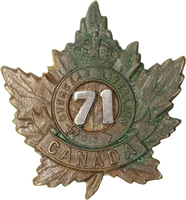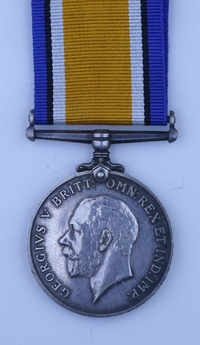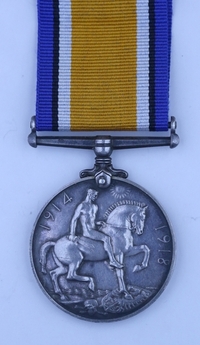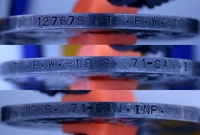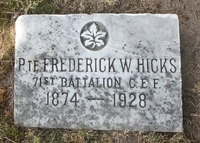
127678 Pte Frederick Walter Hicks
71st Canadian Overseas Battalion
By: Capt (ret'd) Michael M. O'Leary, CD, The RCR
Frederick Walter Hicks was born in Wootton Bassett, Somerset, England, on 19 Jun 1873. Hicks' parents, Robert and Ellin, had a total of fourteen children, though not all survived childhood. Hicks also had a step-brother by Thomas' third wife.
On 2 Sep 1899, Hicks (26) married Blanche Hamilton (22) at Hersham, St. Peter, Surrey, England. Over the next 12 years, the couple would have four children, Blanche (b. 1900), Frederick Alfred (b. 1902), Delcy Mary (b. 1906, various spellings of name include Delsy and Delsie), and Sidney (b. 1912).
At the time of the 1911 Census, the Hicks were living at Walton on Thames, Surrey, England. Over the next two years, the family would emigrate to Canada.
Frederick Hicks sailed for Canada, alone, in advance of the rest of the family. Crossing the Atlantic aboard the Cunard liner S.S. Ausonia, he departed Southampton, Eng., and landed at Portland. Maine, USA, on 22 Apr 1912. The passenger list records his intended trade in Canada as farm labourer, the same trade he had in England. Hicks' intended place of residence was Burford, Ontario, a small community in the County of Brant, midway between Woodstock and Brantford. Hicks's entry on the passenger list is stamped "C.G.E.A.," which stands for "Canadian Government Employment Agent." This indicates that his passage was arranged by an agent who received a commission from the government for coordinating employment for him as a new immigrant. Following that stamp is another which shows "British Bonus Paid" to indicate that the agent had received their bounty.
It was over a year after Frederick sailed for Canada that Blanche followed him to their new home. She sailed from London, Eng., aboard the S.S. Ionian operated by the Allan Line. Only the two younger children, Delcy (7) and Sydney (10 mos.) traveled with their mother. The ship disembarked passengers at Quebec, P.Q., on 16 Sep 1912. Blanche's entry on the Ionian's passenger list reads "To husband on the C.P.R., 1 1/2 years in Canada." Their intended destination was Port Colborne, Ont.
The family would not be complete until the arrival in Canada of their two older children. Blanche (12) and Alfred (11) sailed from Liverpool, Eng., aboard the Canadian Pacific steamship R.M.S. Empress of Britain and landed at Quebec on 25 Oct 1913. Notes on their entry in the passenger list read "going to parents, in charge of agent." Blanche and Alfred were heading for Brantford, Ont.
Hicks attested for service in the Canadian Expeditionary Force (C.E.F.) with the 71st Overseas Battalion at Woodstock, Ont., on 3 Jan 1916. A 41-year-old labourer, Hicks was described on his attestation paper as 5 feet 6 1/2 inches tall, weighing 160 pounds, with a 37-inch chest, a dark complexion, hazel eyes, and brown-gray hair. His religious denomination was Church of England. Hicks identified his wife, Blanche Hicks, 130 Hansfield Rd., Woodstock, Ont., as his next of kin. On attesting with the 71st Battalion, Hicks was given the service number 127678. He was examined by Capt. Charles MacKay, Medical Officer of the 22nd Regiment, Oxford Rifles, and the 71st Battalion, C.E.F., and was pronounced fit.
The 71st Bn., C.E.F., was mobilized at and recruited in Woodstock, Ont. Authorized on 15 Aug 1915, the battalion embarked for Great Britain on 1 Apr 1916 when it sailed aboard the S.S. Olympic. The 71st Bn. provided reinforcements to the C.E.F. until 30 Sep 1916, at which time its remaining personnel were absorbed by the 44th, 51st, 54th and 74th Battalions.
Six weeks after enlisting, on 18 Feb 1916, Hicks was admitted to the General Hospital in Woodstock. Suffering from a sprained ankle, which was later determined to be fractured, he was transferred to the London Field Hospital at Wolseley Barracks on 22 Feb 1916, and back to the General Hospital in Woodstock on 27 Feb 1916, from where he would be discharged on 11 Mar 1916. While in hospital, he was operated on for bunions on both feet.
The winter of 1915-16 constituted months of preparatory training for the battalion. General military skills, marksmanship, general fitness training and marksmanship would have been common and repetitive activities. Further training for the unit, based on current experiences at the front in France and Flanders, awaited the battalion in England. It was on 1 Apr 1916, that Hicks and the 71st Bn. embarked at Halifax aboard the S.S. Olympic and sailed for England. The unit disembarked at Liverpool on 11 Apr 1916 and headed for Shorncliffe.
Commencing April, 1916, Hicks established a monthly Pay Assignment of $20 to be sent to his wife. As a Private in the C.E.F., Hicks was paid $1.00 per day plus an additional ten cents daily field allowance. His pay assignment represented about two-thirds of his monthly pay. Blanche Hicks also received $20 monthly Separation Allowance, which began in January, 1916, and ceased on her husband's return to Canada.
After little more than a month overseas in England, on 17 May 1916, Hicks was the subject of Army Form B.204: "Application for Discharge of a recruit as not likely to become an Efficient Soldier." This was completed by the Medical Officer (the same officer who pronounced Hicks fit in January) and the Commanding Officer of the 71st Battalion. The reasons for this application were succinctly presented as "was operated on for bunions of both feet, March 1, '16; feet still troubling him and unable to drill." The form also stated that Hicks "cannot stand route marches." The following day, on 18 May 1916, the Deputy Assistant Director of Medical Services (D.A.D.M.S.) for Canadian Troops, Bramshott Camp, signed off the form "Recommended."
While Hicks waited for the administration to catch up with the recommendation for his discharge, it was clear that he would not be joining a reinforcement draft for France. Instead, on 12 Jun 1916, he was transferred to the Base Company at Oxney Camp, Hampshire. Five days later, on 17 Jun 1916, he was transferred to the Canadian Casualty Assembly Centre (C.C.A.C.) at Folkestone. Men were sent to the C.C.A.C. when they needed to be assessed for treatment and return to duty or for invaliding home to Canada.
Shortly after arriving in Folkestone, on 19 Jun 1916, Hick's case was considered by a Pensions and Claims Board assembled at Prior Park, Bath. His condition at the time was noted as "Good except feet." The Board's recommendation stated: "The Board, having considered the evidence of Pte. F.W. Hicks No. 127678 71st. Bn. and the documents submitted, hereto attached and marked, which form part of these Presents:— Recommends:— That this man be not granted a Pension."
Hicks was struck off the strength of the Overseas Military Forces of Canada (O.M.F.C.) when he proceeded to Canada on 22 Jun 1916 for Discharge, Medically Unfit. His record of service sheet was stamped for the signature of the Commandant of the Canadian Casualty Discharge Depot at Bath, Eng., with the following confirmation: "Discharged under Para 392, Sec. 16, Sub. Sec. C.C., K.R.&O. 1912. Not being likely to become an efficient soldier. Recruit with more than three months service considered medically unfit for further service."
On 23 Jun 1916, Hicks sailed for Canada aboard the S.S. Grampion. Effective his departure from England, Hicks was posted to the District Depot in London, Ont., which would oversee his final discharge. He would not, however, proceed there directly.
Hicks landed in Canada on 1 Jul 1916. The next day, a Medical Board at the Discharge Depot at Quebec confirmed Hicks' 25% incapacity for at least the following three months and a permanent disability beyond that. The Board recorded the following notes on Hicks' condition: "Walks with some difficulty on account of pain across balls of feet when he puts his weight on forepart of feet. He was operated upon for double hallux valgus shortly after enlistment, has never been able to do marching since. With a short rest and lighter boots than he is wearing he should become quite able to resume his work." The Board recommended sending Hicks to a convalescent home.
On 3 Jul 1916, The London Advertiser, of London, Ont., published a short article on men returning from overseas:
"Grampian Brings 66 Home With War Scars
"Another Company of Invalided Landed at Quebec
"[Canadian Press] Quebec, July 3.—Sixty-six Canadian soldiers invalided home reached Quebec Sunday on the Allan liner Grampian."
Included in the list of names which followed was "F.W. Hicks, Woodstock."
Hicks was admitted to the Central Military Convalescent Hospital in Toronto on 5 Jul 1916. He was examined on 14 Aug 1916 and a "Medical History of an Invalid" form completed. The general information on the form described him as being of good conduct and habits, and temperate. It noted that his previous employment at Woodstock has been with a veneer factory.
The medical history form notes Hicks' disability was "hallux valgus," his bunions, which were determined to have originated well before his enlistment, the result of ill-fitting boots. The medical form noted his "Operation for bunions at Woodstock after enlistment. They got better after operation but one still discharging when he went to England, got very sore in England. C.M.H.C. massage and hot pack." With a permanent disability that was assessed as a 25% impairment, Hicks was classified as "unfit." The Medical Board which reviewed his case allowed that half of his impairment was attributable to military service and recommended his discharge from military service. Hicks left the hospital in Toronto on 25 Aug 1916.
On 30 Aug 1916, The London Advertiser, published the following brief article:
"General Reception For All Woodstock Men
"[Special to The Advertiser.]
"WOODSTOCK. Aug. 22.—A public reception to the Woodstock returned soldiers who have returned from the front since last winter will be arranged by the council at its final meeting.
"There has been no public reception to any of Woodstock's returned soldiers since the first lot came home last winter, The general feeling in the council is that such an arrangement is better than a separate reception for each man who returns.
"Pte. Hicks Invalided.
"Pte. Fred Hicks, who left with the 71st Battalion last March, has been invalided home. He was compelled to undergo an operation before he could be accepted as a recruit, and the strenuous campaigning brought on the old trouble."
Nine months after his enlistment, Hicks was discharged from the C.E.F. at Toronto, Ont., on 25 Sep 1916.
On discharge, Hicks was eligible to receive a War Service Gratuity of $300. This was reduced by the amount of his Post Discharge Pay of $160.10 leaving him with $139.90. Blanche also received a spousal amount of $90. Cheques were issued to both of them in installments during July and August, 1916.
On 22 Sep 1919, Hicks' older daughter, Blanche, was married at the age of 19. The wedding took place in Brantford, Ont., and Blanche's husband was 24-year-old English-born labourer, and returned soldier, George Hewitt. With three years prior service with the Brant Dragoons, George has attested for service in the C.E.F. with the 125th Overseas Battalion in January, 1916. He served at the front with the 75th Canadian Infantry Battalion and in 1918 was awarded the Military Medal for his service with that unit.
Hick's younger daughter, Delcy, was married at Brantford on 23 Jan 1924. She married 25-year-old English-born labourer Charles Spiers.
For his service in the C.E.F., having only reached the United Kingdom, Hicks was entitled to receive the British War Medal. This medal was despatched to him at 135 Henry St., Woodstock, Ont., on 4 Jul 1925.
Frederick Walter Hicks died at Brantford, Ont., on 10 Dec 1928 at the age of 54. The cause of his death was recorded as "myocardia failure" which was not attributed to his military service. He is buried in Mount Hope Cemetery, Brantford, Ont. His gravestone reads: "Pte. Frederick W. Hicks, 71st Battalion C.E.F., 1874–1928."
Blanche Hicks survived her husband by another 13 years and died on 20 May 1941 at Brantford, Ont. At the age of 64, the cause of her death was "carcinoma of lung." She is also buried in Mount Hope Cemetery.
Pro Patria
Visit a randomly selected page in The O'Leary Collection (or reload for another choice):
- The O'Leary Collection; Medals of The Royal Canadian Regiment.
- Researching Canadian Soldiers of the First World War
- Researching The Royal Canadian Regiment
- The RCR in the First World War
- Badges of The RCR
- The Senior Subaltern
- The Minute Book (blog)
- Rogue Papers
- Tactical Primers
- The Regimental Library
- Battle Honours
- Perpetuation of the CEF
- A Miscellany
- Quotes
- The Frontenac Times
- Site Map
QUICK LINKS
The O'Leary Collection—Medals of The Royal Canadian Regiment
Newest additions:
![]()
![]() SB-12725 Private Henry "Hank" Ard
SB-12725 Private Henry "Hank" Ard ![]()
WIA at Hill 187, Died of Wounds in Japan
![]()
![]() 2355331 Lance Corporal Albert Lorking
2355331 Lance Corporal Albert Lorking
Wounded in action, later a War Amps representative.
![]()
![]() 4334 / 477996 Pte Isaac Hamilton Wilcox
4334 / 477996 Pte Isaac Hamilton Wilcox
Permanent Force, South Africa, and C.E.F.
![]()
![]() 477019 Private Harold Ashcroft
477019 Private Harold Ashcroft
Transferred to the Tunnelers.
![]()
![]() 734231 Private Clark D. Thompson
734231 Private Clark D. Thompson ![]()
The older Thompson brother, killed in action.
![]()
![]() 733849 Private Norman Parker Thompson
733849 Private Norman Parker Thompson
The younger Thompson brother; post-war service in the Special Guard.
![]()
![]()
![]() A305 / 400305 Private Andrew Walker
A305 / 400305 Private Andrew Walker ![]()
"Previously reported Wounded, now Killed in Action."
![]()
![]() 823298 Pte Thomas Patrick Steele, M.M.
823298 Pte Thomas Patrick Steele, M.M. ![]()
… for gallant conduct in the field …
![]()
![]() P13066 Sergeant Harold Thompson
P13066 Sergeant Harold Thompson
Instrumental Soloist for over 20 years of Canadian Army service.
![]()
![]() 9609 / 477728 Private Albert Edward Piper
9609 / 477728 Private Albert Edward Piper
"Arrived from England as a STOWAWAY …"
